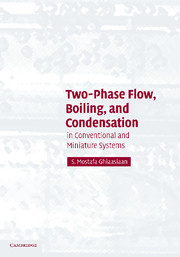Book contents
- Frontmatter
- Contents
- Preface
- Frequently Used Notation
- TWO-PHASE FLOW, BOILING AND CONDENSATION IN CONVENTIONAL AND MINIATURE SYSTEMS
- PART ONE TWO-PHASE FLOW
- 1 Thermodynamic and Single-Phase Flow Fundamentals
- 2 Gas–Liquid Interfacial Phenomena
- 3 Two-Phase Mixtures, Fluid Dispersions, and Liquid Films
- 4 Two-Phase Flow Regimes – I
- 5 Two-Phase Flow Modeling
- 6 The Drift Flux Model and Void–Quality Relations
- 7 Two-Phase Flow Regimes – II
- 8 Pressure Drop in Two-Phase Flow
- 9 Countercurrent Flow Limitation
- 10 Two-Phase Flow in Small Flow Passages
- PART TWO BOILING AND CONDENSATION
- APPENDIX A Thermodynamic Properties of Saturated Water and Steam
- APPENDIX B Transport Properties of Saturated Water and Steam
- APPENDIX C Thermodynamic Properties of Saturated Liquid and Vapor for Selected Refrigerants
- APPENDIX D Properties of Selected Ideal Gases at 1 Atmosphere
- APPENDIX E Binary Diffusion Coefficients of Selected Gases in Air at 1 Atmosphere
- APPENDIX F Henry's Constant of Dilute Aqueous Solutions of Selected Substances at Moderate Pressures
- APPENDIX G Diffusion Coefficients of Selected Substances in Water at Infinite Dilution at 25°C
- APPENDIX H Lennard–Jones Potential Model Constants for Selected Molecules
- APPENDIX I Collision Integrates for the Lennard–Jones Potential Model
- APPENDIX J Physical Constants
- APPENDIX K Unit Conversions
- References
- Index
6 - The Drift Flux Model and Void–Quality Relations
- Frontmatter
- Contents
- Preface
- Frequently Used Notation
- TWO-PHASE FLOW, BOILING AND CONDENSATION IN CONVENTIONAL AND MINIATURE SYSTEMS
- PART ONE TWO-PHASE FLOW
- 1 Thermodynamic and Single-Phase Flow Fundamentals
- 2 Gas–Liquid Interfacial Phenomena
- 3 Two-Phase Mixtures, Fluid Dispersions, and Liquid Films
- 4 Two-Phase Flow Regimes – I
- 5 Two-Phase Flow Modeling
- 6 The Drift Flux Model and Void–Quality Relations
- 7 Two-Phase Flow Regimes – II
- 8 Pressure Drop in Two-Phase Flow
- 9 Countercurrent Flow Limitation
- 10 Two-Phase Flow in Small Flow Passages
- PART TWO BOILING AND CONDENSATION
- APPENDIX A Thermodynamic Properties of Saturated Water and Steam
- APPENDIX B Transport Properties of Saturated Water and Steam
- APPENDIX C Thermodynamic Properties of Saturated Liquid and Vapor for Selected Refrigerants
- APPENDIX D Properties of Selected Ideal Gases at 1 Atmosphere
- APPENDIX E Binary Diffusion Coefficients of Selected Gases in Air at 1 Atmosphere
- APPENDIX F Henry's Constant of Dilute Aqueous Solutions of Selected Substances at Moderate Pressures
- APPENDIX G Diffusion Coefficients of Selected Substances in Water at Infinite Dilution at 25°C
- APPENDIX H Lennard–Jones Potential Model Constants for Selected Molecules
- APPENDIX I Collision Integrates for the Lennard–Jones Potential Model
- APPENDIX J Physical Constants
- APPENDIX K Unit Conversions
- References
- Index
Summary
The Concept of Drift Flux
The drift flux model is the most widely used diffusion model for gas–liquid two-phase flow. It provides a semi-empirical methodology for modeling the gas–liquid velocity slip in one-dimensional flow, while accounting for the effects of lateral (cross-sectional) nonuniformities. In its most widely used form, the DFM needs two adjustable parameters. These parameters can be found analytically only for some idealized cases and are more often obtained empirically. These empirically adjustable parameters in the model turn out to have approximately constant values or follow simple correlations for large classes of problems, however.
Recall that the diffusion models for two-phase flow only need one set of momentum conservation equations, often representing the mixture. Knowing the velocity for one of the phases (or the mixture), one can use the model's slip velocity relation (or its equivalent) to find the other phasic velocity. When used in the cross-section-average phasic momentum equations, the DFM thus leads to the elimination of one momentum equation. The mixture momentum equation can be recast in terms of mixture center-of-mass velocity. The elimination of one momentum equation leads to a significant savings in computational cost. Also, using the DFM, some major difficulties associated with the 2FM (e.g., the interfacial transport constitutive relations, the difficulty with flow-regime-dependent parameters, and numerical difficulties) can be avoided. These advantages of course come about at the expense of precision and computed process details.
Consider a one-dimensional flow shown in Fig. 6.1. Assume all parameters are time averaged.
Information
- Type
- Chapter
- Information
- Two-Phase Flow, Boiling, and CondensationIn Conventional and Miniature Systems, pp. 173 - 185Publisher: Cambridge University PressPrint publication year: 2007
